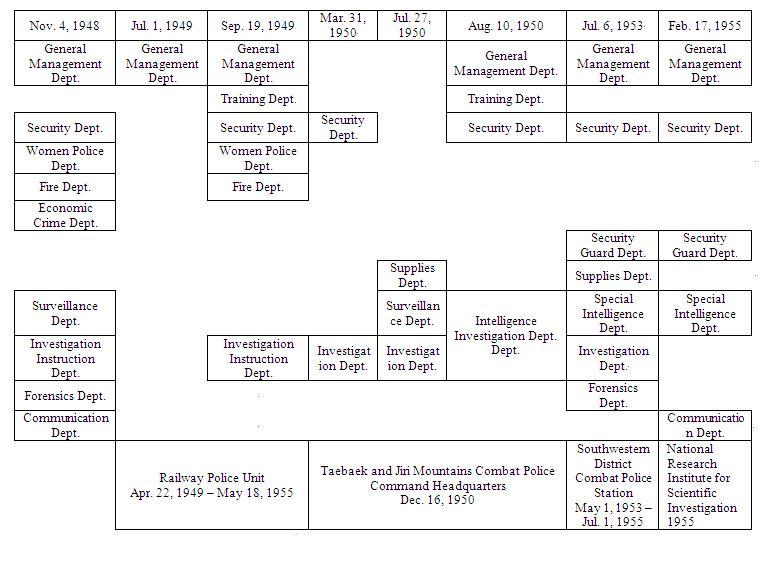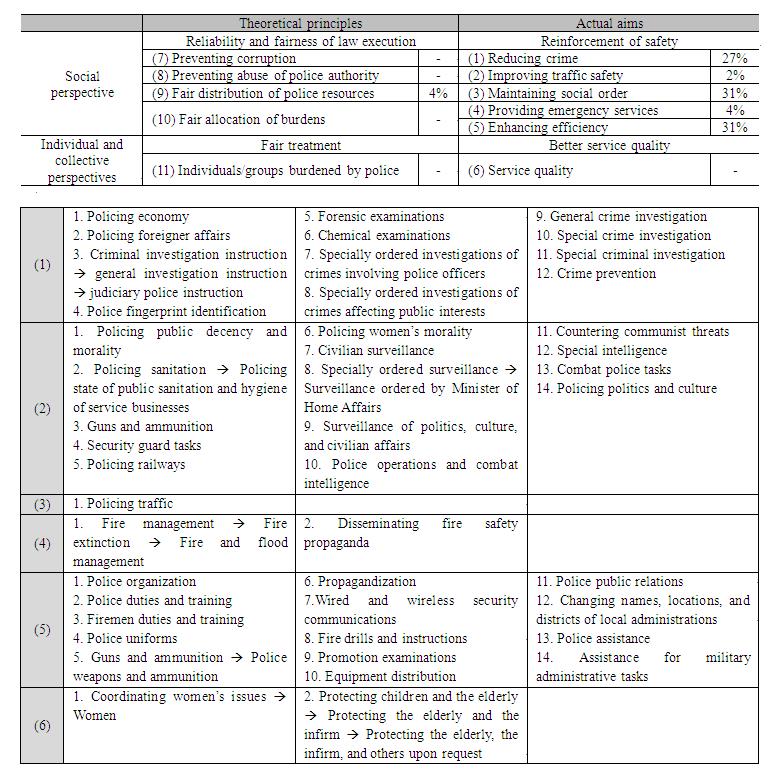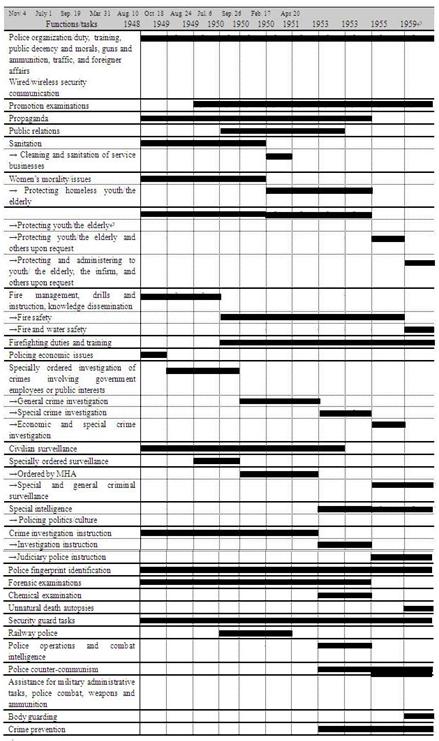Public Safety Administration 1
Analysis of Organizational and Functional Evolution of the Korean Police
1. First Republic
(1) Organizational Changes
The first government of Korea, helmed by President Rhee Syngman, inherited mostly intact the administrative organization of the U.S. Army Military Government in Korea (USAMGIK). The Department of Police, however, was downgraded to the Public Safety Bureau in the Ministry of Home Affairs (MHA), although its personnel and staff remained more or less the same. The process of enacting the National Government Organization Act (NGOA) sparked sharp debate on the floor of the National Assembly over whether to grant the Department of Police institutional independence or downsize the organization. The members finally voted to repeal the proposal for independence (Lee et al., 1968). Presidential Decree 18 of November 4, 1948, led to the creation of the general management, security, economics, surveillance, investigation instruction, forensics, communication, policewomen, and fire divisions in the Public Safety Bureau (NPA, 1995). A number of changes were made in the role of the police with its reorganization. First, whereas the USAMGIK, with its liberal policy, had abolished the economic control function of the police agency that had been introduced by the Japanese colonial regime, the Rhee administration restored that function, creating the Economic Division as part of the police organization. Second, the Policewomen Division, created by the USAMGIK to reform its political image and emphasize the police organization’s role as a servant of the people, remained intact even after the overall Police Bureau was downsized. Third, the Fire Division was installed as part of the Police Bureau, thus integrating the formerly separated police and firefighting functions. Fourth, the Police Bureau retained its communication function, as public communication had emerged as quite an important issue amid the social chaos of the USAMGIK’s rule. Fifth, the forensics component of the investigation organization under the USAMGIK was given an independent division of its own as part of efforts to end the use of torture tactics in investigations and show greater to respect human rights. The First Republic saw seven division-level reforms in total, as shown in Figure 2-1.

[Figure 2-1] Organizational Changes in the Police in the First Republic
The Economic Division was abolished in July 1949, while police education and training, formerly handled by the General Management Division, was transferred to the newly created Training Division in September of the same year. The fire and policewomen divisions were abolished by April 1950, with their functions absorbed by the single Security Division. Police officers were converted into combat soldiers when the Korean War broke out, and the War Supplies Division was set up in July 1950 for distribution of military supplies to police officers. The Security Guard Division came into being after the end of the Korean War to handle matters related to security guards and the combat police force, and the Intelligence Investigation Division was separated into the special intelligence and the investigation divisions to improve investigatory processes. The wartime system came to an end in 1955, at which time the War Supplies Division was abolished and its tasks and roles transferred to the Security Guard Division (in February of that year). The main features of police organization reforms during the First Republic can be summarized as follows. First, combat became an important function of the police due to the outbreak of the Korean War, and the combat police force was kept intact even after the war ended. Not only were new divisions for war supplies and security guards created, but the Public Safety Bureau also became semi-militarized, with the addition of several new organizational features such as the Railway Police Unit, the Taebaek-Jiri Mountains Combat Command Headquarters, the Southwestern District Police Station, and the like.
Second, the concept of police work as a form of “service,” embodied by the policewomen and firefighting divisions first introduced by the USAMGIK, came to all but disappear. Though the Policewomen Division, in particular, performed valuable community services during the time of its existence, including the instruction of women and housewives, the education of delinquent youth, the assurance of public decency and morality, and the protection of the elderly, the infirm and others in need, it was ultimately closed down without much effect (Lee, 1968, 225).
Third, the police came to exert a greater influence on politics through its surveillance and special intelligence divisions. The latter, in particular, had three subdivisions and its own central office. Subdivision 2 was tasked with gathering intelligence and information on the political and electoral activities of National Assembly members, political parties, religious organizations, public institutes, and citizens in general, as well as on elections, the publication of banned books and texts, and other anti-national and illegal activities (MHA Public Safety Bureau, 1973, 601).
Source: Korea Institute of Public Administration. 2008. Korean Public Administration, 1948-2008, Edited by Korea Institute of Public Administration. Pajubookcity: Bobmunsa.
During the First Republic, the divisions of the Public Safety Bureau gained 44 new tasks or functions. Table 2-3 categorizes the roles and tasks of the police during this period according to the analytical framework of this study.[1] As shown in the table, 31 percent of the new tasks pertained to maintaining social order; another 31 percent, to enhancing the efficiency of police work in general; 27 percent, to reducing crime; 4 percent, to providing emergency rescue services; 4 percent, to ensuring fair distribution of police resources; and 2 percent, to improving traffic safety.
Interestingly, the overall emphasis was more on maintaining social order than on the more essential function of the police, i.e., crime reduction. This trend reflects the lingering impact of the Korean War. As Table 2-4 shows, police operations, combat intelligence, police combat, distribution of police weapons and ammunition, police support for the military and military administrative tasks,[2] and counter-communism activities were newly introduced as key tasks of the police during these years, reflecting the increasing militarization of the police organization. Moreover, the Security Guard Division was newly created. Improving the efficiency of police tasks in general was another significant concern, evidenced by the defining and introduction of specific duties, training and education for police for the first time in the organization’s history. After the Policewomen Division was shut down, the Security Guard Division took over its responsibilities as stipulated by Presidential Decree 183 of September 19, 1949. The Policewomen Division disappeared even in name, however, as part of organizational reforms undertaken according to Presidential Decree 996 of February 17, 1955, reflecting the weakening perception of police work as “service.” Though the duty to protect the elderly and the infirm, remained intact throughout the First Republic, the majority of the police tasks during this period concerned social control and repression of violence. Crime prevention, accordingly, became an important part of the Investigation Instruction Division.
[Table 2-3] Police Principles and Aims in the First Republic

[Table 2-4] Changes in Police Functions and Tasks in the First Republic[3]

Analysis of Organizational and Functional Evolution of the Korean Police
1. First Republic
(1) Organizational Changes
The first government of Korea, helmed by President Rhee Syngman, inherited mostly intact the administrative organization of the U.S. Army Military Government in Korea (USAMGIK). The Department of Police, however, was downgraded to the Public Safety Bureau in the Ministry of Home Affairs (MHA), although its personnel and staff remained more or less the same. The process of enacting the National Government Organization Act (NGOA) sparked sharp debate on the floor of the National Assembly over whether to grant the Department of Police institutional independence or downsize the organization. The members finally voted to repeal the proposal for independence (Lee et al., 1968). Presidential Decree 18 of November 4, 1948, led to the creation of the general management, security, economics, surveillance, investigation instruction, forensics, communication, policewomen, and fire divisions in the Public Safety Bureau (NPA, 1995). A number of changes were made in the role of the police with its reorganization. First, whereas the USAMGIK, with its liberal policy, had abolished the economic control function of the police agency that had been introduced by the Japanese colonial regime, the Rhee administration restored that function, creating the Economic Division as part of the police organization. Second, the Policewomen Division, created by the USAMGIK to reform its political image and emphasize the police organization’s role as a servant of the people, remained intact even after the overall Police Bureau was downsized. Third, the Fire Division was installed as part of the Police Bureau, thus integrating the formerly separated police and firefighting functions. Fourth, the Police Bureau retained its communication function, as public communication had emerged as quite an important issue amid the social chaos of the USAMGIK’s rule. Fifth, the forensics component of the investigation organization under the USAMGIK was given an independent division of its own as part of efforts to end the use of torture tactics in investigations and show greater to respect human rights. The First Republic saw seven division-level reforms in total, as shown in Figure 2-1.

[Figure 2-1] Organizational Changes in the Police in the First Republic
The Economic Division was abolished in July 1949, while police education and training, formerly handled by the General Management Division, was transferred to the newly created Training Division in September of the same year. The fire and policewomen divisions were abolished by April 1950, with their functions absorbed by the single Security Division. Police officers were converted into combat soldiers when the Korean War broke out, and the War Supplies Division was set up in July 1950 for distribution of military supplies to police officers. The Security Guard Division came into being after the end of the Korean War to handle matters related to security guards and the combat police force, and the Intelligence Investigation Division was separated into the special intelligence and the investigation divisions to improve investigatory processes. The wartime system came to an end in 1955, at which time the War Supplies Division was abolished and its tasks and roles transferred to the Security Guard Division (in February of that year). The main features of police organization reforms during the First Republic can be summarized as follows. First, combat became an important function of the police due to the outbreak of the Korean War, and the combat police force was kept intact even after the war ended. Not only were new divisions for war supplies and security guards created, but the Public Safety Bureau also became semi-militarized, with the addition of several new organizational features such as the Railway Police Unit, the Taebaek-Jiri Mountains Combat Command Headquarters, the Southwestern District Police Station, and the like.
Second, the concept of police work as a form of “service,” embodied by the policewomen and firefighting divisions first introduced by the USAMGIK, came to all but disappear. Though the Policewomen Division, in particular, performed valuable community services during the time of its existence, including the instruction of women and housewives, the education of delinquent youth, the assurance of public decency and morality, and the protection of the elderly, the infirm and others in need, it was ultimately closed down without much effect (Lee, 1968, 225).
Third, the police came to exert a greater influence on politics through its surveillance and special intelligence divisions. The latter, in particular, had three subdivisions and its own central office. Subdivision 2 was tasked with gathering intelligence and information on the political and electoral activities of National Assembly members, political parties, religious organizations, public institutes, and citizens in general, as well as on elections, the publication of banned books and texts, and other anti-national and illegal activities (MHA Public Safety Bureau, 1973, 601).
Source: Korea Institute of Public Administration. 2008. Korean Public Administration, 1948-2008, Edited by Korea Institute of Public Administration. Pajubookcity: Bobmunsa.
(2) Functional Changes
During the First Republic, the divisions of the Public Safety Bureau gained 44 new tasks or functions. Table 2-3 categorizes the roles and tasks of the police during this period according to the analytical framework of this study.[1] As shown in the table, 31 percent of the new tasks pertained to maintaining social order; another 31 percent, to enhancing the efficiency of police work in general; 27 percent, to reducing crime; 4 percent, to providing emergency rescue services; 4 percent, to ensuring fair distribution of police resources; and 2 percent, to improving traffic safety.
Interestingly, the overall emphasis was more on maintaining social order than on the more essential function of the police, i.e., crime reduction. This trend reflects the lingering impact of the Korean War. As Table 2-4 shows, police operations, combat intelligence, police combat, distribution of police weapons and ammunition, police support for the military and military administrative tasks,[2] and counter-communism activities were newly introduced as key tasks of the police during these years, reflecting the increasing militarization of the police organization. Moreover, the Security Guard Division was newly created. Improving the efficiency of police tasks in general was another significant concern, evidenced by the defining and introduction of specific duties, training and education for police for the first time in the organization’s history. After the Policewomen Division was shut down, the Security Guard Division took over its responsibilities as stipulated by Presidential Decree 183 of September 19, 1949. The Policewomen Division disappeared even in name, however, as part of organizational reforms undertaken according to Presidential Decree 996 of February 17, 1955, reflecting the weakening perception of police work as “service.” Though the duty to protect the elderly and the infirm, remained intact throughout the First Republic, the majority of the police tasks during this period concerned social control and repression of violence. Crime prevention, accordingly, became an important part of the Investigation Instruction Division.
[Table 2-3] Police Principles and Aims in the First Republic

[Table 2-4] Changes in Police Functions and Tasks in the First Republic[3]

[1] In cases of overlapping tasks that differed in name only, tasks under the final names were analyzed. Tasks whose scopes were contracted or expanded during the same period, however, were treated as different, separate tasks.
[2] The police acquired military tasks from the Ministry of National Defense (MND) and the local bureaus and handled local conscription.
[3] The bold lines in this table indicate the period of time in which each duty or task was carried out. For instance, the table shows that the tasks of police organization/duty and training, policing public decency and morals/guns and ammunition/traffic/foreigner affairs, and security communications remained in place throughout the duration of the First Republic. The tasks of promotion examinations, on the other hand, were introduced only under Presidential Decree 183 of September 19, 1949, in the course of police organizational reforms. The tasks of public sanitation, cleaning, and hygiene (pertaining to service businesses) were first placed in the category of “Policing sanitation” under Presidential Decree 18 of November 4, 1948, upon the organization of the MHA, but were later grouped under “Policing cleaning and the sanitation of service businesses” before finally disappearing under Presidential Decree 525 of August 24, 1951.
Source: Korea International Cooperation Agency. 2004. Study on Development Aid and Cooperation for South Korea: Size, Scope and Exemplary Effects. Seoul.
Source: Korea International Cooperation Agency. 2004. Study on Development Aid and Cooperation for South Korea: Size, Scope and Exemplary Effects. Seoul.
